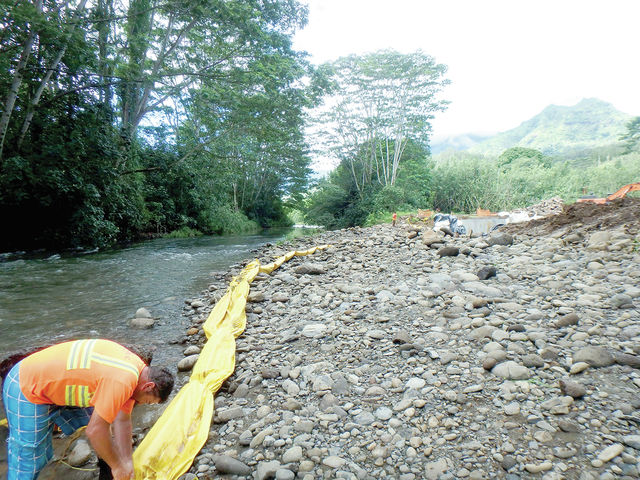LIHUE — State regulators said Thursday that a Hanalei River restoration project site does not appear to have discharged large amounts of sediment into Hanalei Bay as a result of heavy rainfall earlier this week. At least one environmentalist —
LIHUE — State regulators said Thursday that a Hanalei River restoration project site does not appear to have discharged large amounts of sediment into Hanalei Bay as a result of heavy rainfall earlier this week.
At least one environmentalist — Hanalei biologist and videographer Terry Lilley — isn’t buying what the state is saying, however.
Sheeting piling installed prior to the recent rainstorms appears to have prevented the flooding of Hanalei River from eroding a soil stockpile and other features at the work site, according to Alec Wong of the state Department of Health’s Clean Water Branch.
Officials from the Department of Land and Natural Resources, which is responsible for the river restoration project, said sediment runoff originating from the upper watershed are to blame for the brown water issue.
The bay’s blue hue turned a yellowish brown in the aftermath of the rainstorms, prompting the issuance of a brown water advisory Wednesday.
The river was sediment-free when two Clean Water Branch inspectors from the DOH toured the site Wednesday, Wong said. The inspectors met with representatives from site contractor Goodfellow Bros. and civil engineering consultants AECOM.
As a result of Wednesday’s inspection, Wong said the project managers will, however, need to implement additional erosion and sediment controls to reduce the risk of future polluted discharges.
Specifics about the nature of those additional measures were not made available Thursday.
“The submitted plans will need to be reviewed and analyzed for permit compliance and technical feasibility,” Wong said.
More than 30,000 tons of eroded soil and sediment have fallen into the bay since the Hanalei River jumped its banks in 1995, according to the DLNR.
Over the years, this breach has caused numerous problems in the area, according to DLNR, including environmental pollution, loss of property, stream and reef degradation, and loss of water for nearby taro fields and the Hanalei Wildlife Refuge.
The riverbank stabilization project currently underway has a goal of returning the river back to its original form by restoring the 100-foot section of eroded stream bank located on state land above the refuge.
The project will also ensure a consistent flow of water in the Hanalei River, which is the primary source used for taro cultivation and wetland habitat within the refuge, according to Carty Chang, administrator of DLNR’s Engineering Division.
If left untreated, DLNR says the river would continue to carve a new channel across private and state-owned properties, and ultimately leave 1,000 feet of the Hanalei River dry.
Over the years, flood flows have repeatedly broken through emergency repairs, with the breach channel expanding after every major flood, according to DLNR.
This week, when heavy rains began washing sediment into Hanalei River and Bay, Lilley grew concerned about the river restoration project and, in an email to residents and public officials, said the source of the sediment is not the upper watershed but rather a soil stockpile situated along the river about 100 yards from the Hanalei Bridge.
“With this last rain that we had, all of the mud and soil from this restoration site just washed out into the river and out into Hanalei Bay,” Lilley told The Garden Island earlier this week. “It’s probably one of the single worst disasters I’ve ever seen environmentally along the coastline.”
Lilley, who compared the sediment event to the Ka Loko Dam break that killed seven people in 2006 when a wall of water washed them out to sea, said he plans to file a complaint for violation of the Clean Water Act.
But Chang said Lilley’s claim that the sediment flooding into Hanalei River and Bay are from the restoration project is inaccurate.
“We have been working closely with the U.S. Army Corps of Engineers and the Hawaii Department of Health to obtain all required permits and to ensure that all best management practices are in place,” Chang said. “We are in compliance and any concerns that the Hanalei Restoration Project is causing sediment runoff into the bay is inaccurate.”
In response to Lilley’s concerns, the DOH’s Clean Water Branch started investigating the soil stockpile. The DOH has been monitoring the project for several months, along with the Army Corps of Engineers, according to DOH officials.
The DOH inquiry into the soil stockpile revealed that some sediment control best management practices were in place. DLNR has been using a silt fencing and filter socks along the perimeter of the stockpile where stormwater could potentially discharge soil into the river.
On Thursday, Lilley said he didn’t believe what the state was saying, and that the project was directly responsible.
“If they follow this line of B.S., we will file a lawsuit,” he said.
Based on its review of the site, the DOH recommended that DLNR also use impervious sheeting on top of the soil to further prevent runoff into the river, DOH officials said.
The sediment does not appear to be located in a wetland or otherwise concerning area, according to the DOH.
•••
Brittany Lyte, environmental reporter, can be reached at 245-0441.



